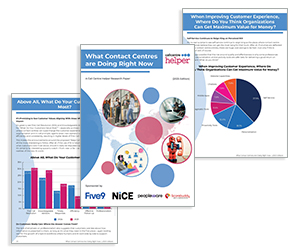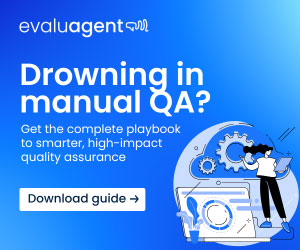Quality management (QM) technology makes it easier to capture the full agent and customer experience across the entire contact centre environment.
In this article, experts from Scorebuddy and Calabrio explain everything you need to know to get started with quality management (QM) technology.
What Is Quality Management (QM) Technology?
Quality management (QM) technology provides an effective set of tools to measure and monitor agent performance, assess the quality and depth of customer interactions, and drive continual improvements that positively impact the business as a whole.
Quite simply, QM technology makes it easier to capture the full agent and customer experience to monitor, evaluate, and improve quality processes across the entire contact centre environment in a more efficient way, essentially creating a customer experience command centre, so you can track every customer across every channel and every interaction.
How Does QM Technology Work?
QM technology enables you to capture and evaluate agent–customer interactions across all channels, so you can drive continuous improvement in your call centre.
By defining quality standards and establishing target metrics, you can measure your performance against these benchmarks.
For example, by leveraging technology like speech analytics, text analytics, and predictive analytics, you can pinpoint potential areas for improvement, whether it’s targeted coaching for a particular agent, or fixing a process flaw that is limiting productivity.
A QM solution will also make it easier to:
- Identify the customer interactions that provide the best insight into performance and streamline evaluation, making the most of each evaluator’s time.
- Search for and share customer interactions that should be reviewed by evaluators, managers, and agents.
- Deliver timely agent feedback.
- Monitor, measure, and compare performance around key metrics throughout the day.
What Are the Key Features of QM Technology?
It helps to think of QM technology as the customer experience command centre of your contact centre, with all evaluation tools in one place.
Therefore, the best QM solutions encompass a broad range of integrated capabilities to guarantee a robust quality programme.
Here are the essentials to look out for:
Call Recording
Recording agent–customer interactions allows you to review these interactions in real time or at a later date. Using these tools you can assess call quality and identify any potential areas for improvement.
Depending on your aims, you can focus on agent performance metrics like script adherence, emotional intelligence, query resolution, and more. You can even use recorded calls as a training tool, so agents can listen and learn from their own mistakes.
Looking for some top advice on using call recordings in the contact centre? Read our article: The Top Ten Uses for Call Recordings
Reporting
A built-in reporting suite can support supervisors and managers by providing a comprehensive overview of contact centre performance. Typically, you can customize reports to focus on KPIs that matter the most to your business.
By drilling down into the data behind these KPIs, whether it’s First Call Resolution (FCR), CSAT, NPS, or anything else relevant to your aims, you can gain a greater understanding of what’s working – and what isn’t – and use these insights to inform your decision-making.
Omnichannel Capabilities
Tech-savvy consumers expect to contact your company in multiple ways and receive a consistent, seamless experience, regardless of whether they use web, chat, email, phone, or a combination of communication channels. Your QM solution needs to be able to support this.
Desktop Monitoring
It is useful to understand agent effectiveness and drive agent productivity by determining which resources they use and whether their activities are productive.
When combined with other metrics that gauge agent effectiveness – such as average quality evaluation score, the number of positive sentiment calls received, or agent adherence rates – desktop monitoring adds a new dimension to QM technology.
Real-Time Monitoring
Desktop monitoring can also include real-time monitoring of both the audio and screen activity of an agent.
For example, you might decide to monitor a newer agent while they’re on a call to see if onboarding training is effective, or to follow an agent who is struggling with a difficult customer and step in with real-time support.
Analytics
Many platforms now include analytics tools to facilitate a more in-depth understanding of agent–customer interactions and the underlying data. Using analytics, you can identify trends and patterns, as well as outliers that may need immediate attention.
Some analytics tools even support automatic call scoring based on predefined criteria, including average handling time, agent tone, customer satisfaction, and more.
We have a great article on analytics in the contact centre. For more information, read: An Introduction to… Contact Centre Analytics
Speech Analytics
This forms a valuable part of QM software because it unlocks the voice of the customer by turning raw customer interaction data into relevant and readily usable insights.
Consider using speech analytics to analyse and identify the most relevant calls for quality assurance purposes quickly and accurately.
Sentiment Analysis
This goes one step further, leveraging speech analytics to provide intelligence about your customers’ moods.
Sentiment analysis automatically determines customer sentiment by utterance and looks at those utterances in the context of the words around them to uncover a deeper understanding of the full customer experience. Customer sentiment can then be fed into your QM solution.
We have a great video article on sentiment analysis that you should watch if you want to find out more: What Is Sentiment Analysis?
Metadata Integration
Metadata is additional information about an interaction that gets automatically attached to the interaction and is available for playback as soon as the recording is complete.
You can integrate and attach third-party metadata sources, such as customer data from third-party post-interaction surveys, to store all information in one place along with the full contact recording and transcription.
Post-Call Surveys
These can provide valuable information about your customers’ interaction experiences and insight into their general perceptions about your organization.
They can also help target interactions for evaluation. When combined with agent self-evaluations, post-call survey data provides a 360-degree view of an interaction.
Performance Management & Coaching
Building automated performance management and coaching into your QM solution is an effective way to keep agents feeling supported, engaged, and motivated to cope with the stresses of working in a modern contact centre.
Use them to monitor real-time performance, assess quality objectives, and identify skills gaps, individual challenges, successes and opportunities for personal growth and development.
Which Areas of the Contact Centre Can Quality Management Technology Help to Improve?
Deploying digital quality management technology raises the bar for quality in the following ways:
Customer Experience
It can help you deliver a strong customer experience. QM technology allows you to monitor and evaluate agent–customer interactions so you can identify areas where CX is falling below the desired standard and take corrective action.
Saving Money
In a tough economic climate, anything you can do to reduce your overall operational costs will benefit the organization.
Using QM technology, you can identify inefficiencies and poor performance that are leading to wastage.
Delivering coaching to improve First Call Resolution (FCR), for example, will mean fewer resources are required to resolve the issue.
Saving Time
It can save time for busy supervisors and quality professionals by simplifying QM processes and reporting – all within one integrated platform.
Employee Engagement
It can increase employee engagement with timely feedback loops and built-in gamification tools. Meanwhile, customizable dashboards can allow agents to monitor their performance and chart their own path to self-improvement – wherever they are.
For more suggestions on how to increase employee engagement, read our article: How to Motivate Staff and Drive Employee Engagement
Compliance
It can capture and evaluate every single customer interaction across all channels while keeping customer data safe and secure to aid effective compliance management.
Data Management
It can see the bigger picture with a holistic and unified view of everything contact centres need to gauge performance and drive improvements.
At a glance, contact centres leaders can have a clear view of all audio and screen recordings, survey data, workforce management (WFM), and speech and text analytics results.
Calabrio Case Study – Republic Services
Waste & recycling giants Republic Services implemented Calabrio’s Quality Management solution to correlate call quality scores with sales numbers to better motivate agents and drive revenue growth.
The company has streamline call centre operations with the ability to quickly identify oversights and gaps in delivery processes.
At the same time, it has developed superior training and development programmes, and achieved stronger customer loyalty across the board.
According to Dough Sanders, IT Director: “As agents saw their QM scores improve, they were also able to see a similar uptick in their sales and revenue numbers as well.
This has led to new growth and advancement opportunities for the agents, and really has fostered a more professional workplace environment.“
What Should You Watch Out for With Quality Management (QM) Technology?
Here are the most common challenges users face. You should address these first to release the full potential of your QM technology investment:
Quality Is Low on the Priority List
This usually happens if you haven’t done your homework when putting together a quality programme and auditing management systems. Always put the customer at the heart of the programme, then pull in the right business units and stakeholders.
There Isn’t Enough Time to Analyse Data
When structural issues or organizational growth result in multiple systems, the amount of data generated can be overwhelming.
Aim to eliminate data silos using automated, integrated customer experience and QM technology so that analysts are not forced to compile information manually.
Evaluators Lack Skill or Consistency
It’s important to have consistency in how you monitor your agents and to remember quality isn’t a one-off project.
It’s a constantly evolving programme that considers changes to people, processes, technology, and the overall business.
There Isn’t Enough Time to Coach and Train Agents
Supervisors know that consistent coaching has a direct impact on agent performance, and they need to make sure coaches are effective.
Yet finding the time to proactively coach and train agents – while juggling all their normal day-to-day duties – is a challenge for most contact centres, with or without a QM solution. Try to address this in a positive and proactive way to get the most out of your investment.
Change the Metrics
Rather than obsess over the number of conversations per hour or average handling times, focus instead on metrics that evaluate the human factor of digital interactions and allow agents to showcase their soft skills.
There is always a danger that team leaders may be chasing metrics. To find out more, read our article: Are Your Team Leaders Too Busy Chasing Metrics?
Make Sure It’s Scalable
Scalability is a concern when investing in quality management technology. Remember that QM technology is a long-term investment in your company’s future, not just a customer service quick fix.
Consider the ability of your chosen technology to scale as your organization grows. Will it be able to support an increase in interactions and manage associated data?
Plan for Integration
Most people won’t be investing in quality management and setting up the call centre at the same time.
Realistically, you already have your own tools and infrastructure in place to handle various tasks, quality management or otherwise.
So make sure that whatever technology you choose is capable of seamlessly integrating with your existing call centre systems and software.
How Much Should I Budget for Quality Management (QM) Technology?
In terms of software, you can expect to pay anywhere between £50,000 and £150,000 for an on-site solution, and for a cloud-based solution from £70 to £100 per agent per year – up to £500 per agent per year.
To drill down into specifics, it can help to speak to different QM vendors about your needs.
In doing so, you can compare and contrast the offerings from different companies to determine the average price range of a solution for a call centre of your size.
Additionally, if you have access to peers or industry experts who have experience with this technology, it’s not a bad idea to pick their brains.
Beyond this, it can also help to focus on the end goal and ROI instead of a fixed budget figure. For example, how QM technology can help lower employee attrition, and therefore retain your best talent and save money on expensive and time-consuming recruitment programmes.
With special thanks to Jennifer Docken at Calabrio and the experts at Scorebuddy for this article.
We have more great articles on quality management, so if you want to know more, you should read these next:
- Call Centre Quality Parameters: Creating the Ideal Scorecard and Metric
- 11 Tips and Tools to Improve Call Centre Quality Assurance (QA)
- Call Centre Quality Assurance: How to Create an Excellent QA Programme
Author: Megan Jones
Reviewed by: Robyn Coppell
Published On: 9th Oct 2023 - Last modified: 2nd Sep 2025
Read more about - Technology, An Introduction to Contact Centres, Calabrio, Monitoring, Quality, Scorebuddy

















